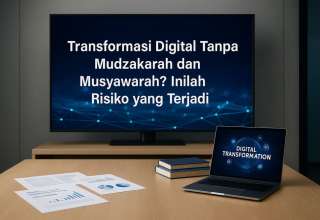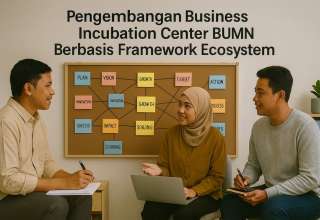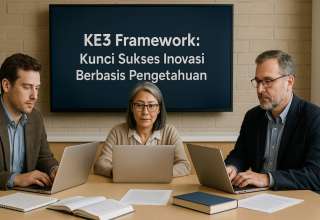*) Gambar sebagai ilustrasi
The SKILLS Framework: A Strategic Model for Skills Management in the Negeri Framework Ecosystem
Developed by Mohamad Haitan Rachman
Introduction: Why Skills Matter in a Changing World
The 21st century workplace is defined by disruption, innovation, and relentless transformation. Technology evolves faster than traditional education systems can adapt. Globalization blurs boundaries between industries and nations. Artificial intelligence, automation, and digital platforms are redefining the value of human work. In this new reality, the central question for individuals, organizations, and nations is no longer “What job do you have?” but “What skills do you bring, and how fast can you adapt?”
The World Economic Forum and leading global consultancies emphasize the rise of the skills-based economy, where hiring, promotion, and organizational design are increasingly based on demonstrable skills rather than static job titles or degrees. For countries like Indonesia and many developing economies, this transition represents both a challenge and an opportunity. A challenge, because millions of workers need to reskill to remain relevant. An opportunity, because skills—unlike natural resources—are renewable, transferable, and scalable across generations.
It is in this context that Mohamad Haitan Rachman, founder of Negeri Framework and Inovasi Semesta Ilmu (INOSI), developed the SKILLS Framework. Designed as part of his broader ecosystem of frameworks—including SUCCESS, TALENT, PERFORM, CYCLE, PRODUCT, and KE3—the SKILLS Framework provides a structured, actionable, and sustainable model for skills management.
Unlike generic training models, the SKILLS Framework is a strategic model that integrates skills identification, development, deployment, and sustainability into a continuous cycle. It positions skills not only as individual assets, but as organizational and societal resources that drive innovation, competitiveness, and resilience.
This essay explores the philosophy, structure, application, and impact of the SKILLS Framework, situating it within the larger Negeri Framework ecosystem.
1 – Understanding Skills Management
From Competency to Skills
Traditional human resource management often focused on competencies, broad categories combining knowledge, skills, and behaviors. While competency dictionaries remain valuable for defining standards, they are often abstract and difficult to operationalize. Organizations increasingly prefer the more concrete, measurable language of skills.
A “skill” is a specific, demonstrable capacity to perform a task—such as coding in Python, negotiating a contract, or creating a marketing strategy. Skills can be measured, learned, and improved over time. This makes them ideal units for modern talent management systems.
The Gap in Practice
Despite the emphasis on skills, many organizations lack a structured approach to managing them. Skills inventories are incomplete, training programs are reactive rather than strategic, and employees often cannot see how their personal skill growth connects to career progression or organizational goals. This leads to misalignment, wasted resources, and talent attrition.
The SKILLS Framework responds to this gap by offering a systematic, six-step process:
- Scan – Identify and map existing skills.
- Know the Gaps – Analyze differences between current and required skills.
- Improve – Develop skills through structured interventions.
- Leverage – Deploy skills in the right roles, teams, and projects.
- Link – Connect skills to performance, career growth, and strategy.
- Sustain – Ensure skills remain relevant through lifelong learning.
2 – The Structure of the SKILLS Framework
S – Scan
The starting point of skills management is visibility. Many organizations do not actually know what skills their workforce possesses. The Scan phase involves creating a skills inventory or skills matrix, mapping individuals against specific skill categories and proficiency levels.
Tools:
- Surveys and self-assessments.
- Supervisor evaluations.
- HR information systems (HRIS) and skills-tracking software.
- AI-based skills inference from resumes, projects, and digital footprints.
At the personal level, “scanning” means self-reflection and self-audit. An individual asks: “What skills do I currently have, and how strong am I in each?”
K – Know the Gaps
Once skills are mapped, the next step is identifying the gaps between current capabilities and future requirements. This step is both diagnostic and strategic.
- Diagnostic: Compare actual skills to required skills for specific roles, projects, or organizational strategies.
- Strategic: Anticipate emerging skills needs (e.g., AI literacy, sustainability practices, intercultural collaboration).
Methods include skills gap analysis, benchmarking against industry standards, and scenario planning.
I – Improve
Knowing the gap is meaningless unless it is followed by action. The Improve phase focuses on upskilling and reskilling, using diverse learning interventions:
- Formal training (courses, certifications, workshops).
- Informal learning (mentoring, communities of practice, peer learning).
- Digital learning (e-learning platforms, micro-learning, MOOCs).
- Experiential learning (job rotation, stretch assignments, innovation projects).
Improvement is not just about technical skills. It includes soft skills—communication, leadership, creativity—that are often more enduring across careers.
L – Leverage
Skills become valuable only when applied. The Leverage phase ensures that employees with the right skills are deployed into the right projects, roles, and teams. It prevents underutilization of talent and maximizes impact.
Leverage requires:
- Skills-based workforce planning.
- Project staffing aligned to skill profiles.
- Internal mobility platforms that allow employees to find roles matching their skills.
For individuals, leverage means actively seeking opportunities to use and showcase skills, thereby strengthening mastery and visibility.
L – Link
Skills are not ends in themselves. They must be linked to outcomes—performance, career development, innovation, and organizational strategy.
- At the individual level: Linking skills to career paths and personal growth.
- At the organizational level: Linking skills to KPIs, Balanced Scorecards, and strategic objectives.
- At the societal level: Linking skills development to national competitiveness, entrepreneurship, and sustainable development goals (SDGs).
S – Sustain
The final element is sustainability. Skills depreciate quickly in a fast-changing world. What was cutting-edge yesterday may be obsolete tomorrow. The Sustain phase emphasizes:
- Lifelong learning as a culture.
- Continuous reskilling and adaptation.
- Embedding learning into daily work.
- Encouraging curiosity, exploration, and reflection.
Sustainability ensures that the SKILLS Framework is not a one-time project but a continuous cycle of growth.
3 – Integrating SKILLS into the Negeri Framework Ecosystem
Connection with TALENT Framework
The TALENT Framework (Trace, Align, Learn, Express, Nurture, Transform) developed by Mohamad Haitan Rachman aligns closely with SKILLS. For example:
- Learn and Nurture correspond to the Improve phase.
- Transform echoes the Sustain element, ensuring personal growth.
Together, TALENT and SKILLS form a comprehensive model for human capital development.
Connection with PERFORM Framework
The PERFORM Framework (Plan, Execute, Reflect, Overcome, Refine, Maintain) provides the performance cycle that ensures skills are applied effectively. SKILLS feeds into PERFORM by identifying what capabilities are needed to deliver excellence.
Connection with KE3 Framework
Knowledge Exploration, Enrichment, and Exploitation (KE3) is about transforming knowledge into value. The SKILLS Framework is the human translation of KE3, converting knowledge assets into practical skills that drive innovation and execution.
Connection with SUCCESS Framework
The SUCCESS Framework (Smart Understanding, Understanding, Creativity, Clarity, Exploration, Strategy, Synthesis) emphasizes strategic thinking and growth. By aligning SKILLS with SUCCESS, organizations ensure that skills are not developed randomly but strategically—supporting innovation, clarity, and synthesis.
4 – Applications of the SKILLS Framework
1. For Individuals
- Career Planning: Use SKILLS to identify personal strengths, gaps, and learning plans.
- Employability: Map personal skills to labor market demands.
- Lifelong Learning: Build sustainable learning habits through the Sustain phase.
2. For Organizations
- Workforce Planning: Create skills inventories to allocate talent effectively.
- Learning & Development (L&D): Design training aligned with actual skills gaps.
- Performance Management: Link skills to performance metrics and KPIs.
- Innovation: Deploy cross-functional teams with complementary skills.
3. For Education Institutions
- Curriculum Design: Build programs aligned with industry skills requirements.
- Teaching Factories and Incubators: Use SKILLS to guide experiential learning.
- Graduate Employability: Link student skills to career pathways.
4. For National Policy
- Skills-Based Economy: Use SKILLS as a national model for workforce development.
- Vocational Training: Align TVET programs to emerging industry skills.
- Lifelong Learning Culture: Promote reskilling as a societal norm.
5 – Benefits and Impact
- Clarity: The SKILLS acronym provides an easy-to-remember roadmap.
- Measurability: Skills can be tracked, rated, and benchmarked.
- Flexibility: The framework applies across individuals, organizations, and nations.
- Integration: SKILLS connects seamlessly with other Negeri Framework models.
- Sustainability: Emphasis on lifelong learning ensures relevance in the digital age.
6 – Challenges and Solutions
- Challenge: Resistance to change.
- Solution: Use the Link phase to show employees how skills benefit their careers.
- Challenge: Rapid obsolescence of skills.
- Solution: Emphasize Sustain, embedding reskilling as a continuous process.
- Challenge: Data and measurement gaps.
- Solution: Leverage HR tech, AI, and analytics for accurate skills mapping.
- Challenge: Balancing soft and hard skills.
- Solution: Ensure Improve includes both technical training and behavioral development.
Conclusion: Building a Skills-Based Future
The SKILLS Framework by Mohamad Haitan Rachman is more than an HR tool—it is a strategic philosophy for thriving in the skills-based economy. It empowers individuals to take charge of their growth, enables organizations to align talent with strategy, and supports nations in building competitive, innovative, and sustainable workforces.
Within the broader Negeri Framework Ecosystem, SKILLS provides the operational backbone for talent development, ensuring that knowledge (KE3), performance (PERFORM), leadership (LEADER, KAPASITAS, SUCCESS), and innovation (PRODUCT, CYCLE) are all grounded in the practical reality of human skills.
In a world where jobs may vanish but skills endure, the SKILLS Framework offers a roadmap for resilience, adaptability, and continuous progress. It is a call to individuals, organizations, and societies: scan, know, improve, leverage, link, and sustain your skills—because the future belongs to those who never stop learning.


